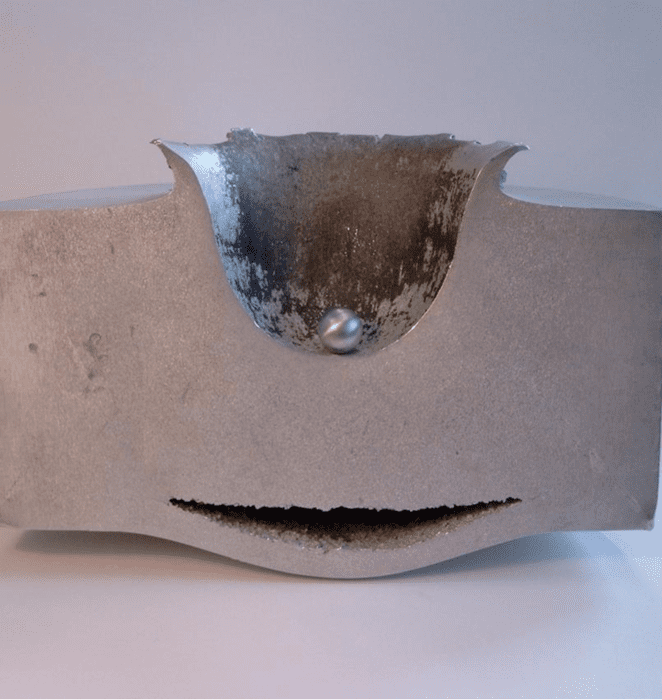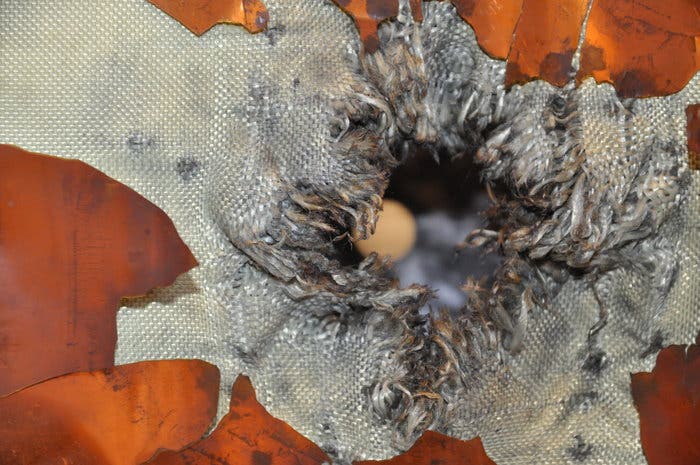The European Space Agency recently shared this image of a tiny, 10-cm object that can wreak havoc in even the strongest space armor we have.

ESA space debris studies, an impact sample. This is the kind of damage even a small projectile can cause. Image credits: ESA.
There is a growing concern regarding the sheer number of random objects in outer space, be they natural or man-made. Needless to say, all these objects pose a great risk to spacecraft, because they typically travel at extremely high velocities. For instance, an object just 10 cm across would inflict catastrophic damage and potentially cause the disintegration of the target. This happens due to the extremely high velocities at which they travel, which can reach 15 km/s for space debris and 72 km/s for meteoroids. Just so you can make an idea, bullets almost never go above 400 meters per second, so debris travels about 37 times faster than a bullet.
Even extremely small objects can have a major impact. Recently, the ISS’ Cupola — the dreamy vantage point which astronauts use to take amazing pictures — was chipped by a paint flake or small metal fragment no bigger than a few thousandths of a millimetre across. The problem is not only the impact itself but also that the speed of these rogue objects causes additional shockwaves which further the damage. The ESA explains:
“Beyond 4 km/s (depending on the materials), an impact will lead to a complete breakup and melting of the projectile, and an ejection of crater material to a depth of typically 2–5 times the diameter of the projectile. In hypervelocity impacts, the projectile velocity exceeds the speed of sound within the target material. The resulting shockwave that propagates across the material is reflected by the surfaces of the target, and reverses its direction of travel. The superimposition of progressing and reflected waves can lead to local stress levels that exceed the material’s strength, thus causing cracks and/or the separation of spalls at significant velocities.”

This was caused by “possibly a paint flake or small metal fragment no bigger than a few thousandths of a millimetre across,” writes the ESA.
It’s counterintuitive, but big objects aren’t really as problematic as small objects. Larger objects can be tracked and studied and perhaps avoid — or at the very least, we can prepare for it. But smaller objects are virtually untraceable and can be quite surprising, striking out of nowhere. According to NASA, there are millions of pieces of debris or ‘space junk’ orbiting Earth. Recently the ESA shared its latest figures according to which there are around 5,000 objects larger than 1 meter in orbit, 20,000 larger than 10cm, and 750,000 larger than 1cm. All these pose a risk for all spacecraft, which is why researchers are trying to develop better and safer armor. Notably, the ESA is working on Whipple shields with aluminium and Nextel–Kevlar bumper layers.
Whipple shields are quite clever in their approach. They consist of a relatively thin outer bumper spaced some distance from the main spacecraft wall. This will cause a bumper which is not expected to stop the particle or even remove most of its energy, but rather to break it and disperse its energy, dividing the original particle into many fragments, spread across a greater surface. Intermediate fabric layers further slow the cloud particles. The original particle energy is spread more thinly over a larger wall area, which is more likely to withstand it. Nowadays, Whipple shields have reached a stage of maturity, so they’ll likely be incorporated into the next generation of spacecraft — potentially even SpaceX shuttles.

A 7.5 mm-diameter aluminium bullet was shot at 7 km/s towards the same ‘stuffed Whipple shield’ design used to protect the ATV and the other International Space Station manned modules. Image credits: ESA.
Future research will try to further our understanding of such impacts, because the risks get higher every day. If we want to start exploring Mars or other areas of the solar system, or even if we just want to secure Earth’s orbit for future spacecraft, armor is key. With every piece of spacecraft and satellite we launch. the risks get higher.









